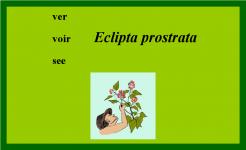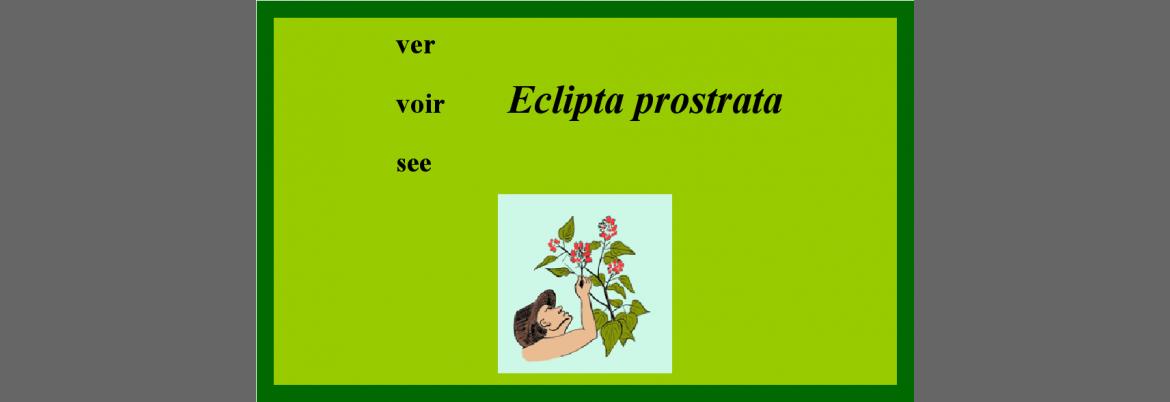1 SOLIS P, CORREA M, GUPTA M, 1995
Encuesta TRAMIL (Comunidades afro-caribeñas). Centro de Investigaciones Farmacognósticas de la Flora Panameña CIFLORPAN, Facultad de Farmacia, Universidad de Panamá, Panamá, Panamá.
2 GOVINDACHARI T, NAGARAJAN K, PAI B, 1956
Wedelolactone from Eclipta alba. J Sci Ind Res-B 15:664-665.
3 BHARGAVA K, KRISHNASWAMY N, SESHADRI T, 1970
Isolation of demethyl wedelolactone and its glucoside from Eclipta alba. Indian J Chem 8(7):664-665.
4 SARG T, ABDEL SALAM N, EL-DOMIATY M, KHAFAGY S, 1981
The steroid, triterpenoid and flavonoid constituents of Eclipta alba (L.) Hassk. (Compositae) grown in Egypt. Sci Pharm 49:262-264.
5 WAGNER H, GEYER B, KISO Y, HIKINO H, RAO G, 1986
Coumestans as the main active principles of the liver drugs Eclipta alba and Wedelia calendulacea-1. Planta Med 5:370-374.
6 BOHLMANN F, ZDERO C, 1970
Polyacetylene compounds. Part 173. Constituents of Eclipta erecta. Chem Ber 103:834-841.
7 SINGH P, 1988
Naturally-occuring thiophene derivatives from Eclipta species. Bioact Mol 7:179-186.
8 SINGH P, SHARMA A, JOSHI K, BOHLMANN F, 1985
A further dithienylacetylene from Eclipta erecta. Phytochemistry 24(3):615-616.
9 KRISHNASWAMY N, SESHADRI T, SHARMA B, 1966
Synthesis of alpha-terthienylmethanol, a component of Eclipta alba. Curr Sci 35(21):542.
10 JAIN S, SINGH P, 1988
A dithienylacetylene ester from Eclipta erecta Linn. Indian J Chem Ser B27(1):99-100.
11 SIKRORIA BC, SRIVASTAVA SJ, NIRANJAN GS, 1982
Phytochemical studies on Eclipta alba. J Indian Chem Soc 59 (7):905.
12 SINGH P, BHARGAVA S, 1992
A dithienylacetylene ester from Eclipta erecta. Phytochemistry 31(8):2883-2884.
13 PAL S, NARASIMHAM N, 1943
The alkaloid inEclipta alba (Hassk). J Indian Chem Soc 20:181.
14 ZOU J, UCHIYAMA M, 1993
Chemical constituents of yerbadetajo (Eclipta prostrata). Chung Ts'ao Yao 24(4):174-176.
15 DUKE JA, ATCHLEY AA, 1986
Handbook of proximate analysis tables of higher plants. Boca Raton, USA: CRC Press. p67.
16 KOSUGE T, YOKOTA M, SUGIYAMA K, YAMAMOTO T, NI M, YAN S, 1985
Studies on antitumor activities and antitumor principles of Chinese herbs. I. Antitumor activities of Chinese herbs. Yakugaku Zasshi 105(8):791-795.
17 SATO A, 1989
Studies on anti-tumor activity of crude drugs. I. The effects of aqueous extracts of some crude drugs in short-term screening test. Yakugaku Zasshi 109(6):407-423.
18 GHISALBERTI E, SKELTON B, WHITE A, 1995
Structural study of torquatone, an acylphloroglucinol derivative from Eucalyptus species. Aust J Chem 48(10):1771-1774.
19 TRIRATANA T, PARIYAKANOK P, SUWANNURAKS R, NAENGCHOMNOG W, 1988
The study of medicinal herbs on coagulation mechanism. J Dent Assoc Thai 38(1):25-30.
20 THYAGARAJAN S, THIRUNEELAKANTAN K, SUBRAMANIAN S, SUNDARAVELU T, 1982
In vitro inactivation of hbsag by Eclipta alba Hassk and Phyllanthus niruri Linn. Indian J Med Res 76S:124-130.
21 KUSUMOTO I, NAKABAYASHI T, KIDA H, MIYASHIRO H, HATTORI M, NAMBA T, SHIMOTOHNO K, 1995
Screening of various plant extracts used in Ayurvedic medicine for inhibitory effects on human immunodeficiency virus type 1 (HIV-1) protease. Phytother Res 9(3):180-184.
22 RIPATHI R, TRIPATHI R, 1982
Reduction in bean common mosaic virus (bcmv) infectivity vis-a-vis crude leaf extract of some higher plants. Experientia38(3):349-349.
23 DHAR ML, DHAR MM, DHAWAN BN, MEHROTRA BN, RAY C, 1968
Screening of Indian plants for biological activity: part I. Indian J Exp Biol 6:232-247.
24 MINSHI Z, 1989
An experimental study of the anti-hsv II action of 500 herbal drugs. J Trad Chinese Med 9(2):113-116.
25 ZHENG M, 1988
An experimental study of antiviral action of 472 herbs on Herpes simplex virus. J Trad Chin Med 8(3):203-206.
26 AOVI S, KHAN M, VOHORA S, 1991
Anti-bacterial, anti-fungal and anthelmintic investigations on Indian medicinal plants. Fitoterapia 62(3):221-228.
27 HADKE S, KULKARNI S, 1989
Screening of in vitro antibacterial activity of Terminalia chebula, Eclapta alba and Ocimum sanctum. Indian J Med Sci 43(5):113-117.
28 FAROUK A, BASHIR A, SALIH A, 1983
Antimicrobial activity of certain Sudanese plants used in folkloric medicine. Screening for antibacterial activity (I). Fitoterapia 54(1):3-7.
29 VERPOORTE R, DIHAL P, 1987
Medicinal plants of Surinam. IV. Antimicrobial activity of some medicinal plants.
J Ethnopharmacol 21(3):315-318.
30 NENE Y, THAPLIYAL P, KUMAR K, LABDEV, 1968
Screening of some plant extracts for antifungal properties. J Sci Tech B 6(4):226-228.
31 AL-SHAMMA A, MITSCHER L, 1979
Comprehensive survey of indigenous Iraqi plants for potential economic value. I. Screening results of 327 species for alkaloids and antimicrobial agents. J Nat Prod 42:633-642.
32 MISRA P, PAL N, GURU P, KATIYAR J, TANDON J, 1991
Antimalarial activity of traditional plants against erythrocytic stages of Plasmodium berghei. Int J Pharmacog 29(1):19-23.
33 MISHRA A, DOGRA J, SINGH J, JHA O, 1979
Post-coital antifertility activity of Annona squamosa and Ipomoea fistulosa. Planta Med 35:283-285.
34 MENDES N, PEREIRA N, DE SOUZA C, LIMA DE OLIVEIRA M, 1984
Preliminary laboratory studies for the verification of molluscicidal activity of several species from the Brazilian flora. Rev Saude Publ Sao Paulo 18:348-354.
35 IJAYALAKSHIMI K, MISHRA S, PRASAD S, 1979
Nematicidal properties of some indigenous plant materials against second stage juveniles of Meloidogyne incognita (Koffoid and White) Chitwood. Indian J Entomol 41(4):326-331.
36 KIUCHI F, HIOKI M, NAKAMURA N, MIYASHITA N, TSUDAY, KONDO K, 1989
Screening of crude drugs used in Sri Lanka for nematocidal activity on the larva of Toxocaria canis. Shoyakugaku Zasshi 43(4):288-293.
37 DEBELMAS A, HACHE J, 1976
Toxicity of several medicinal plants of Nepal including some behavioral and central nervous system effects. Plant Med Phytother 10:128-138.
38 MORS WB, DO NASCIMENTO MC, PARENTE JP, DA SILVA MH, MELO PA, SUAREZ-KURTZ G, 1989
Neutralization of lethal and myotoxic activities of South American rattlesnake venom by extracts and constituents of the plant Eclipta prostrata (Asteraceae). Toxicon27(9):1003-1009.
39 KOSUGE T, YOKOTA M, YOSHIDA M, OCHIAI A, 1981
Studies on antihemorrhagic principles in the crude drugs for hemostatics. I. On hemostatic activities of the crude drugs for hemostatics. Yakugaku Zasshi 101:501-503.
40 SINGH B, SAXENA K, CHANDAN B, AGARWAL S, BHATIA M, ANAND K, 1993
Hepatoprotective effect of ethanolic extract of Eclipta alba on experimental liver damage in rats and mice. Phytother Res 7(2):154-158.
41 CHANDRA T, SADIQUE J, SOMASUNDRARAM S, 1987
Effect of Eclipta alba on inflammation and liver injury. Fitoterapia 58(1):23-32.
42 SAXENA A, SINGH B, ANAND K, 1993
Hepatoprotective effects of Eclipta alba on subcellular levels in rats. J Ethnopharmacol 40(3):155-161.
43 VAISHWANAR I, KOWALE C, JIDDEWAR G, 1976
Effect of two Ayurvedic drugs Shilajeet & Eclinol on changes in liver & serum lipids produced by carbon tetrachloride. Indian J Exp Biol 14:58.
44 SHARMA A, SINGH R, SEHGAL V, HANDA S, 1991
Antihepatotoxic activity of some plants used in herbal formulations.
Fitoterapia 62(2):131-138.
45 KHANNA A, CHANDER R, KAPOOR N, 1991
Hypolipidemic activity of abana in rats. Fitoterapia 62(3):271-274.
46 MISRA M, MISHRA S, MISRA R, 1969
Screening of a few indigenous abortifacients. J Indian Med Assoc 52:535.
47 DHAWAN B, SAXENA P, 1958
A preliminary report evaluation of some indigenous drugs for stimulant effect on the rat uterus. Indian J Med Res 46(6):808-311.
48 MELO P, NASCIMENTO M, MORS W, SUAREZ-KURTZ G, 1994
Inhibition of the myotoxic and hemorrhagic activities of crotalid venoms by Eclipta prostrata (Asteraceae) extracts and constituents. Toxicon 32(5):595-603.
49 KHIN MA-MA, NYUNT N, KHIN MAUNG TIN, 1978
The protective effect of Eclipta alba on carbon tetrachloride-induced acute liver damage. Toxicol Appl Pharmacol 45:723-728.
50 KAPUR RD, 1948
Action of some indigenous drugs on uterus. A preliminary note. Indian J Med Res 36:47.
51 GUPTA S, YADAVA JNS, TANDON JS, 1993
Antisecretory (antidiarrhoeal) activity of Indian medicinal plants against Escherichia coli enterotoxin-induced secretion in rabbit and guinea pig ileal loop models. Int J Pharmacog 31(3):198-204.
52 HAN B, YANG O, KIM Y, HAN Y, 1994
Screening of the platelet activating factor (paf) antagonistic activities on herbal medicines. Yakhak Hoe Chi 38(4):462-468.
53 WAGNER H, FESSLER B, 1986
In vitro 5-lipoxygenase inhibition by Eclipta alba extracts and the coumestan derivative wedelolactone. Planta Med 5:374-377.
54 DABRAL P, SHARMA R, 1983
Evaluation of the role of rumalaya and geriforte in chronic arthritis-a preliminary study. Probe 22(2):120-127.
55 AGRAWAL RC, KAPADIA LA, 1982
Treatment of piles with indigenous drugs-pilex tablets and ointment along with styplon. Probe 21(3):201-204.
56 VIJAYASARATHY V, SHARMA L, PRAKASH A, 1981
Indigenous drug treatment for hemorrhoids. Probe 20(4):285-287.
57 DIXIT S, ACHAR M, 1981
Study of bhringaraja (Eclipta alba) therapy in jaundice in children. J Sci Res Pl Med 2:96-100.
58 ANON 1982
A trial of bhringaraja ghanasatwavati on the patients of Kostha-shakhasrita Kamala (with special reference to hepatocellular jaundice). J Natl Integ Med Assoc 24(9):265-269.
59 SANKARAN J, 1984
An all India multicentric clinical survey on a herbal cure-tefroli for hepatitis. J Natl Integ Med Assoc 26(9):255-261.
60 DIXIT S, ACHAR M, 1979
Bhringaraja (Eclipta alba Linn.) in the treatment of infective hepatitis. Curr Med Pract 23(6):237-242.
61 JAYARAM S, THYAGARAJAN S, PANCHANADAM M, SUBRAMANIAN S, 1987
Anti-hepatitis-B virus properties of Phyllanthus niruri Linn. and Eclipta alba Hassk:in vitro and in vivo safety studies. Bio-Medicine 7(2):9-16.
62 PRAKASH A, PASALU I, MATHUR K, 1979
Ovicidal activity of Eclipta alba Hassk. (Compositae). Curr Sci 48:1090.

